February 2024
Inside This Issue
February is here and in many parts of the country, this unfortunately can be the worst part of winter. The holidays, their excitement, and festive lights seem long gone and spring may still feel a long way off. If you were thinking of a February vacation, don’t worry about missing any new published requirements or interpretations from TJC at this time. This month’s edition of Perspectives has some news about new officer appointments and announcements and the only real content you might want to study in the Consistent Interpretation column.
 Fire Extinguishers:
Fire Extinguishers:
This month’s Consistent Interpretation column discusses four (4) of the 14 elements of performance for LS.02.01.35 and one (1) of the 14 elements from LS.02.01.50. The first EP discussed is EP 10 from LS.02.01.35 which explains travel distance between fire extinguishers, mounting heights, signage, and weight. The noncompliance percentage in 2022 was almost 19%. A common problem with EP 10 is the mounting height of the extinguisher. It must be at least 4 inches off the floor and fire extinguishers that are 40 lbs. or less should be installed so that the top of the extinguisher is not more than 5 feet above the floor.
The guidance/interpretation section for this EP does appear to have an exception if the fire extinguisher is mounted in a cabinet, the top of which is more than 5 feet from the floor, providing the organization has a letter from the fire marshal indicating it is acceptable. However, if the fire extinguisher is mounted directly on the wall with a mounting bracket and the top is more than 5 feet from the floor it will be cited.
The surveyor observation section, although it is not commented on in the interpretation area, does remind us that if fire extinguishers are locked in a cabinet, staff must have access to the keys. Often you will see locked fire extinguishers in behavioral health areas and staff must either have a key or know where to immediately access the key, in the event the fire extinguisher is needed. We still see this issue arising on some psychiatric unit survey reports because keys don’t work, or staff don’t know where to access the key.
The second EP discussed is EP 11 related to class K portable fire extinguishers and their required signage. The noncompliance rate for this EP in 2022 was just under 5%. The interpretation section advises that the class K fire extinguisher must be stored within 30 feet of grease producing appliances, and that there must be a placard near the extinguisher advising staff about the proper use of the class K fire extinguisher.
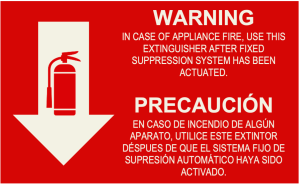
The posted content on the placard should advise users that the kitchen’s over the stovetop automatic suppression system, commonly referred to as the Ansul system, should be activated first, before using the class K fire extinguisher. The automated fire suppression system should work automatically, but if it does not the kitchen also has a pull station where staff can trigger the fire suppression system. Staff need to know where the pull station is located and be able to converse with a surveyor that they would use it if there was a grease fire, and the system did not automatically go off.
Now, you might wonder why scoring of this EP is even at a 5% rate. We often see the placard has fallen off the wall, or been covered by new equipment, or the class K portable fire extinguisher has been relocated and its placard was not also relocated with the fire extinguisher. Do take a look at this year’s TJC Survey Activity Guide (SAG) for the Kitchen Tracer Tool to see how surveyors evaluate these issues in the kitchen.
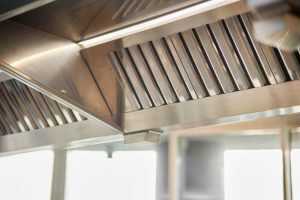 Kitchen Exhaust Hood:
Kitchen Exhaust Hood:
The Consistent Interpretation column next discusses EP 12 which requires that the exhaust hood above grease producing devices not the be the mesh filter type, but rather a heavy gauge steel baffle system that directs accumulated grease to collect and drain in a safe direction and can be removed for proper cleaning. The noncompliance rate for this EP is roughly 6%. Again, take a look at the Kitchen Tracer tool for additional details. One problem that can occur is improperly reinstalling the baffles after cleaning resulting in accumulated grease dripping toward instead of away from the cooking surface.
Automatic Fire Suppression System:
T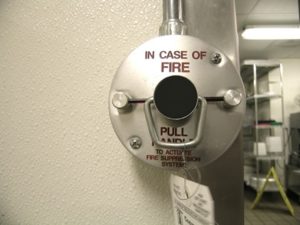 he scoring rate for the next EP, 13 is only 1%. This EP establishes requirements for the additional activities that the automated fire suppression system should trigger, including deactivating the fuel source for the fire, setting off the alarm and controlling the exhaust fans. One potential gotcha that the guidance section warns about is installation of the pull station higher than 48 inches. These should be mounted at least 42 inches off the floor and not higher than 48 inches unless approved by the authority having jurisdiction (AHJ). If yours was installed improperly and at one time approved by the AHJ, make sure the kitchen administrator, facilities director and quality director know where the approval is documented.
he scoring rate for the next EP, 13 is only 1%. This EP establishes requirements for the additional activities that the automated fire suppression system should trigger, including deactivating the fuel source for the fire, setting off the alarm and controlling the exhaust fans. One potential gotcha that the guidance section warns about is installation of the pull station higher than 48 inches. These should be mounted at least 42 inches off the floor and not higher than 48 inches unless approved by the authority having jurisdiction (AHJ). If yours was installed improperly and at one time approved by the AHJ, make sure the kitchen administrator, facilities director and quality director know where the approval is documented.
 Protecting Kitchen Gas Lines:
Protecting Kitchen Gas Lines:
The next standard discussed is LS.02.01.50, EP 1 with almost a 4% noncompliance rate. The EP reads rather generically requiring “equipment using gas or gas piping complies with NFPA 54-2012 and the electrical wiring complies with NFPA 70-2012.” The key noncompliance issue is that buried within NPFA 54-2012 is a requirement to have a restraint or tether on kitchen cooking appliances to prevent them from moving and potentially breaking gas lines.
EC News and this newsletter have had articles on this subject several times over the last few years. Do take a look for this particular issue as it does not appear to be in the Kitchen Tracer tool.
 Environmental Sustainability:
Environmental Sustainability:
The lead article in this month’s EC News describes one organization’s effort around environmental sustainability and the actions they have taken to reduce carbon emissions. As the sustainability accreditation standards have been deferred for now, we won’t go into detail, however there are also cost savings attributable to the energy savings, as well as the use of alternative anesthesia gases that release lesser quantities of CO2.
Age Inclusivity:
 EC News has an article entitled “Age Inclusive Physical Environments” which provides guidance on making the environment more older-adult friendly. The first tip of five tips discussed are on way finding, discussing wall colors, artwork, photographs, and signage. The authors advise contrasting colors for lettering and the sign background, and using sans serif fonts, not the serif font with the artistic extensions on the edges of letters. They also advise signage to be separated from each other, not stacked with directional arrows, and to use laymen’s terminology such as eye clinic instead of ophthalmology.
EC News has an article entitled “Age Inclusive Physical Environments” which provides guidance on making the environment more older-adult friendly. The first tip of five tips discussed are on way finding, discussing wall colors, artwork, photographs, and signage. The authors advise contrasting colors for lettering and the sign background, and using sans serif fonts, not the serif font with the artistic extensions on the edges of letters. They also advise signage to be separated from each other, not stacked with directional arrows, and to use laymen’s terminology such as eye clinic instead of ophthalmology.
As consultants who worked in healthcare facilities for many years and now as consultants who are frequent visitors to healthcare facilities throughout the nation and we do look at signage as we are being escorted through the organization and it always seems quite clear. However as occasional visitors or patients to healthcare organizations, that same signage and way finding is often much less clear than it appeared with an escort leading the way. Organizations might want to consider using friends, neighbors, family members, or volunteers to help critique signage and way finding.
Tips are also provided for improving mobility, lighting, height adjustable exam tables, and acoustics. As the nation ages this guidance may become increasingly valuable, so take a look at this article when time provides.
Sprinkler Escutcheons:
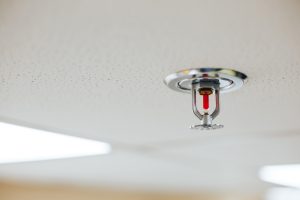 This month’s Q+A column discusses escutcheons which can appear to some people to merely be decorative. The escutcheon is the small, round metal plate surrounding a sprinkler head. However, the escutcheon plate serves and important role in sealing off the area above the ceiling where the sprinkler head penetrates the ceiling.
This month’s Q+A column discusses escutcheons which can appear to some people to merely be decorative. The escutcheon is the small, round metal plate surrounding a sprinkler head. However, the escutcheon plate serves and important role in sealing off the area above the ceiling where the sprinkler head penetrates the ceiling.
If the plate is missing there is usually going to be a gap around the sprinkler head that would allow heat to rise above the ceiling, instead of building up and triggering the sprinkler head to go off. As these escutcheon plates can fall off, it is a good idea to include inspection during EC rounding activities and to train clinical staff of the importance of the escutcheon plate so that they can advise facilities if one falls off in their area.
Approved Accrediting Bodies:
 CMS has posted to its website a listing of all approved accrediting bodies with contact information and website links for all organization provider types with a deemed status relationship. There are 11 accreditors on this listing, 4 of which accredit hospitals.
CMS has posted to its website a listing of all approved accrediting bodies with contact information and website links for all organization provider types with a deemed status relationship. There are 11 accreditors on this listing, 4 of which accredit hospitals.
The 4 approved hospital accrediting bodies are:
- Accreditation Commission for Healthcare (ACHC) ACHC.org
- Center for Improvement in Healthcare Quality (CIHQ) cihq.org
- DNV Healthcare (DNV) https://www.dnv.us/supplychain/healthcare/index.html
- The Joint Commission (TJC) jointcommission.org
The full list can be viewed at: https://www.cms.gov/medicare/provider-enrollment-and-certification/surveycertificationgeninfo/downloads/accrediting-organization-contacts-for-prospective-clients-.pdf
ACHC:
If you browse the ACHC website, you will see they have a variety of resources and educational materials. One of the resources is a quarterly publication called The Surveyor and you can download copies for free. They also have a very useful self-assessment tool to evaluate your compliance with the new USP chapters 795,797 and 800. Like other accreditors they also have educational webinars, both live and on demand.
Under Resources you will see ACHCU, a teaching arm where there are many on demand webinars available for viewing. You should also note that Jennifer Cowel, President of PHC is conducting a webinar on sterilization issues and infection prevention for ACHC on February 6th. Gloria Legere, also of PHC is conducting a webinar on inpatient dialysis services on April 2nd. To view or sign up for one of these free webinars you can visit the following: https://achcu.com/hospital-webinars/
CIHQ:
As you view the CIHQ website you will note that you can download their standards and survey process policies for deemed status surveys. There is also a monthly journal or blog that you can sign up for and view online. Their February edition includes a listing of the most frequently scored condition level findings as well as standard level findings. The most frequently scored condition level finding is standard GL-04 for leadership representing 42% of organizations identified with this condition out of compliance.
This is similar to the pattern we have seen with CMS and TJC in recent years, with leadership being responsible for significant condition level finding and staff being responsible for the condition level findings in the performance area, be it infection prevention, environment or other. As you might have guessed, infection control IC-07 if the second most frequently scored condition level finding. The remaining condition level findings arise from physical plant/life safety code issues and one medication issue on safe administration of medications.
The number one CIHQ standard level finding is life safety code issues with 82% of hospitals getting a standard level finding at CE-15. This is closely followed by IC-03, infection control practices with 75% of hospitals being scored here. Take a look at their newsletter, it is informative, and the issues scored are appropriate for self-evaluation of readiness regardless of accreditor used.
DNV:
The DNV website has a link to access to two years of podcasts that are stored on Spotify that you can listen to as you are driving back and forth to work. We followed a thread to their Advisory Notices and came across a good discussion on changes CMS requires, namely elimination of the ligature extension request process.
In July CMS had published QSO 23-19 (see Patton Post Newsletter July 2023) which somewhat nebulously discussed changes to the elimination of ligature hazards, allowing for greater flexibility of enhanced staffing and monitoring in lieu of creating the ligature free environment. Apparently, there has been additional discussions with accreditors since that July publication and DNV has issued a revised standard and policy guidance on this issue that will help to explain what CMS expected from hospitals regardless of who you use for accreditation. If you look at their Advisory Notices section, you will see guidance for their standard PR.10 and a new version of that standard that will take effect in the spring.
As new content or useful tools come from these accreditors, we will continue to discuss resources that may be helpful to readers.
QSO Memos:
There was one new QSO memo published in the prior month, but this was specifically for organ procurement organizations, not for providers. There were no new QSO memos published for our readers.
Consultant Corner
Dear Readers,
Do you want to be compliant throughout your triennial survey cycle? Your answer should be “YES!”
Mock surveys are pivotal in preparation for your accreditation survey, but don’t forget about what to do the rest of those 3 years.
Contact Us today to schedule your 9-18-24 month post-survey visits!
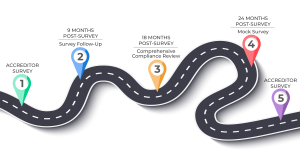 Thank You,
Thank You,
Jennifer Cowel, RN MHSA
JenCowel@PattonHC.com
Julia Finken, RN, BSN, MBA, CPHQ
julia.finken@hbsinc.com
Kurt Patton, MS RPh
Kurt@PattonHC.com
John Rosing, MHA
JohnRosing@PattonHC.com
